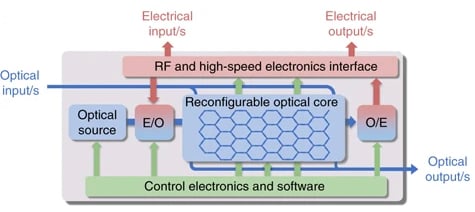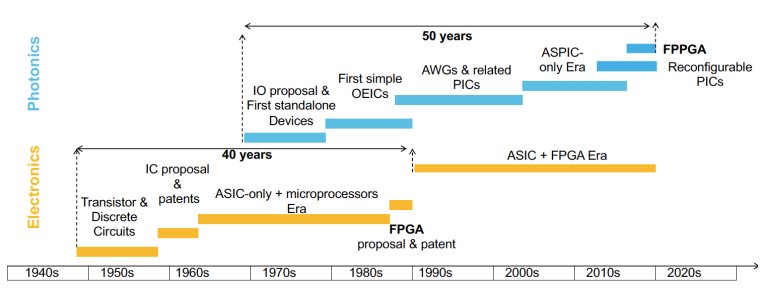Integrated photonics has long made its mark in the fields of high-speed communications. Now, photonics is extending even further into application-specific use cases.
Application-specific photonics gives rise to several technical and logistical challenges, however. In an attempt to alleviate some of these challenges, photonic computing company iPronics is developing software-programmable photonic processor technologies. On July 27, iPronics made headlines when it successfully raised $3.7M to help accelerate the adoption of its technology: the so-called first general-purpose photonic processor that is reconfigurable by software.

Diagram of a software-defined general-purpose photonic processor. Image used courtesy of Nature Communications
Integrated Photonics Get Specific
One of the most important developments in photonics was the development of photonic integrated circuits (PICs).
Integrated photonics shrinks the key components of traditional photonic systems (for instance, those in telecommunications and data centers) onto a single semiconductor die. Integrating everything monolithically can significantly impact overall performance, increasing bandwidth, decreasing size, lowering power consumption, and increasing the reliability of conventional photonics.

Comparison of how both integrated electronics and photonics have evolved. Image used courtesy of iPronics
A subset of integrated photonics is application-specific photonic integrated circuits (ASPICs). Unlike conventional PICs, which are more general-purpose devices, ASPICs are optimized to perform a particular functionality in terms of propagation losses, power consumption, footprint, and the number of components. Compared to PICs, ASPICs tend to offer much better performance for a given application due to their specialized nature.
The Appeal of Application-specific Photonic ICs
Despite their advantages, producing ASPICs requires many design and fabrication iterations, making development extremely slow and expensive. As an alternative, some companies like iPronics are introducing programmable ASPICs.
Programmable ASPICs break down complex photonic circuits into a large network of identical 2D cells implemented in a lattice. In this setup, the PIC can be made programmable with specialized software, which configures and defines the interconnections of each cell. This configuration allows designers to create a unique ASPIC out of the array.

Basic building blocks of programmable photonics. Image used courtesy of iPronics
Similar to the ASIC-versus-FPGA debate, programmable ASPICs offer some advantages that are not obtainable with conventional ASPICs.
The ease of design is possibly the most important benefit of programmable ASPICs. Defining the ASPIC in software allows designers to develop designs and iterate on them as easily as changing lines of code. This greatly reduces the time to market for an ASPIC compared to other hardware-defined solutions.
Beyond this, programmable ASPICs help democratize the adoption of PIC technology because they enable engineers without expertise in hardware or photonics to develop their own products. This ultimately decreases costs for the engineer and the consumer.
iPronics' Next Goal: FPPGA Chips
With iPronics' most recent funding found, the company intends to focus its attention on developing programmable computational photonic cores: devices where programmable photonics are used to perform physical computation. iPronics, a spinoff from the Technical University of Valencia, Spain, currently holds seven patents on this technology.
The $3.7M raised will also help the company grow its R&D teams with the ultimate goal of developing a field-programmable photonic gate array (FPPGA) chip.
